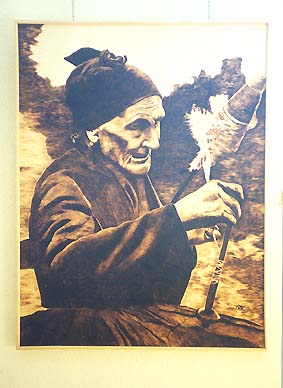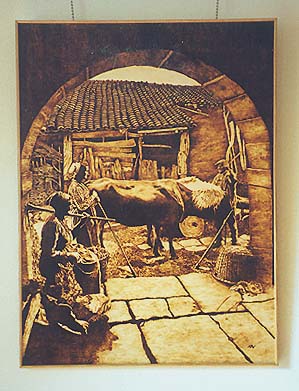

 |
Manu Pagola's Images of the Basque CountryManu Pagola from the Basque Country in Spain, is an autodidactic who has been dedicated to pyrography (pirograbado in Spanish) for more than fifteen years. The reason he is self-taught, Manu explains, is because he knows of no one where he is who does pyrography other than himself. Manu has recently acquired his own website Pirograbados de Manu Pagola where more examples of his work can be viewed. Manu lives in the resort city of San Sebastián, which is the capital of the province of Guipúzcoa in the Basque Country. San Sebastián is situated on the Atlantic coast in the north of Spain only 25 kilometers from the border with France. The Basque Country (País Vasco) is not actually a country but was once a province of Spain. It was declared an autonomous region of Spain in 1990. The Basque people and their Basque language are of unknown origins (one theory in recent years is that they might be of Celtic origin). Unlike Gallego and Catalán, which are dialects of Spain related to Spanish, the Basque language is entirely different. Basques, of course, know Spanish as well, since Castillian Spanish is the official language of their country of Spain. There are more Basques just over the border in France. That province in France where the French Basques live is likewise called Basque Country (Pays Vasque). |
La Hilandera (The Spinner) |
Manu has shown his work in various expositions in San Sebastián and in nearby cities. He is very interested in interpreting the human face within its social context as well as in sports. He has also created a series, which is the one partially shown here, of Basque scenes of an ethnographic character. Manu's high contrast portraits and landscapes, many from old photographs like the ones shown here, tell with haunting beauty of a harsh existence in times past. Manu's goal with this collection is to gather a small visual history of the life of the Basques on the sea as well as on the land.
In The Spinner (shown above), from an antique photograph in a book, Manu depicts the features of an old Basque woman, spinning thread by hand from sheep's wool. This popular image, Manu explained, can frequently be found in the entryways of farmhouses in that region.
|
Ondarroa |
The photographs that are Manu's source of inspiration are of a rural area in his province of Guipúzcoa. One of the coastal towns there is called Ondarroa, which is a town about 80 kilometers from San Sebastián. This pyrograph is also from an antique photograph of that town. It shows the bridge over the river that serves as a seaport for the town, which is located on the banks of the river's mouth.
 |
Caserío (Farmhouse) |
Manu does his pyroengravings from antique photographs of the region in and around San Sebastián, from his own photographs of trips he has taken (especially to Asia), and also from others he has taken of present day landscapes and other topics he finds in his own region. His compelling work entitled Alisha of a Tibetan girl can be found on his website Pirograbados de Manu Pagola . His pyroengraving Desperation of two little girls in India begging can be found there, too, as well as in his salon in the E-Museum Portraits and Paintings Hall
 |
Mirando al Mar (Watching the Sea) |
Typically seen in Basque ports is another image, Watching the Sea, from a book of antique Basque photographs. The Basques have always been very tied to the sea, Manu explains, then adds the reminder that the first man to sail around the world was a Basque named Juan Sebastián del Cano.
Manu wrote about his own modern city of San Sebastián, which he
says is a gorgeous city on the Atlantic Ocean. "We enjoy three
beautiful beaches," Manu says, "of which the prettiest and
most important is Seashell Beach (Playa de la Concha)."
Manu also says that Basque gastronomy is quite varied and Basque cuisine
is considered one of the finest in Europe--and as far as he's concerned,
one of the best in the world.
The climate there is mild, which attracts a lot of tourists who come to
enjoy the beaches, to see the green hills and the pretty coastal and
inland towns, and also, of course, to enjoy that superb Basque cooking.
About the Basques themselves, Manu says, "We are a very open and
hardworking people."
|
Exes and I Pyrographic artist José Eduardo de
Almeida Benelli signs his work simply
Benelli. He is from the city
of Arapongas in Brazil (A little known fact is that Brazil's real name
is the United States of Brazil; Benelli is from the State of
Paraná.) He was born in Apucarana in that state and during the
1970s when he was studying Medical Science at the Federal University of
Paraná, Benelli was living in the city of Curitiba, which is the
capital of his state. Curitiba, a city of two million people, is a very
important cultural center. According to Benelli, Curitiba is considered
a sort of cultural "thermometer" where art events, new films,
concerts, and shows, even new commercial products are first released.
If they are successful in Curitiba, then they are expected to be a hit Brazilwide.
|
|
Pine Trees of Apucarana |
Art is a big part of Benelli's life; in fact, he has been an artist most of his life, drawing and writing poetry since he was a child. He makes his living, however, principally as a physician specializing in both Allergies and Dermatology. That leaves only the weekends for him to dedicate himself to his art work; nevertheless, over the years he has managed to show his work in various galleries. His earlier works (starting in the 1970s) were rendered in either India ink on paper or oils on canvas; however, since he discovered pyrography in 1992, this has been his focus and an important component of a new definition in his style.
|
Falta de Ar (Lack of Air) |
Benelli divides his body of artistic work into three different phases: In the seventies, his work was figurative; in the eighties, concrete-abstract. The nineties brought Benelli's third phase--his neo-expressionist phase--when he started to work through pyrography on wood in rich textures combined with intense acrylic colors.
In 1992, Benelli tried his first
experiments with pyrography on little parquet wood blocks. He followed
the knots and grain of the wood in order to build figures or kinds of
mosaics (see first picture, Exes and I).
Since then, he has gradually been increasing the size of the surface to
be pyroengraved while always searching for new textures deriving from
different shapes and types of wood.
|
Playing Legs |
Following is Benelli's explanation of the progression he has sought in
his art work. It's well worth a careful read to get a much better
understanding of what his compelling neo-expressionist work is all
about. He writes:
I've also been trying to get better visual and technical results
and explore some aspects of the unconscious by symbolically
metamorphosing structures to obtain buildings that more and more float
in smooth spaces of colors. They are delimited by a cubist geometrism
expressed by certain angulations intended to simultaneously produce a
sense of lightness, depth, and solidity.
I've been transposing the reinforced concrete of the buildings to the
wood by means of shapes and textures continuously being modified
according to each new phase and acquiring self identity in the true
sense of being a new object derived from each new rediscovered
universe.
|
Green and White People Tie |
Besides the examples shown here, more of Benelli's work is on display in the E-Museum Portraits and Paintings Hall. There you can see other striking works of bold volumes and vibrant, complex textures that seem to play with your eyes like an Escher trompe l'oeil like his work Lack of Air. You will see how he has taken his work Playing Legs and done a series called "Dancing Couples," showing progressions, abstractions, and variations of the theme, including one with a deliberate medical reference entitled medically and metaphorically (Dancing Couples) In Electroencephalograph Rhythm. There you will also see a larger image of his work Exes and another landscape of Arapongas.
"Art is an important part of my daily routine just as my medical career is. I am intimate with both. My need for artistic expression is extremely strong; it is a component of my essence as a human being."
An earlier article in the E-Zine (linked
here) introduced Sid
Huttner's Lucile Project--his quest to collect a surviving example
of each of the many published versions of the book Lucile.
Since then, a few more pyroengraved versions of Lucile
books have been discovered by Sid and added to both his website and the
E-Museum salon linked here. Two of them are from the same publication;
however, a comparison suggests surprisingly that rather than being
factory stamped pyroengravings as the other editions appear to be, these
may well have been hand done. Click on the Lucile link and see if you agree.
|
"The Sleeping Knitting Girl" A recent addition to the Antique Hall of the E-Museum is this lovely old piece entitled Sleeping Knitting Girl. The mystery that surrounds it is regarding its provenance and biographical information about the artist who signed it--Ball Hughes. Could it be Robert Ball Hughes, a well known sculptor and miniaturist from that period? Also, what about the subject? Could it be the artist's own design, or as one expert, Richard Withers of Wales, suggested, perhaps a pyroengraved copy of a famous (maybe Dutch) painting from a still earlier period? What do you think? Read more and see a larger version in the E-Museum salon, linked here to the title of the piece. |
|
Woodburning with Cheryl Dow: 14
Patterns for Fun or Profit |
Woodburning with Cheryl Dow II |
|
|
Wood Burning: 20 Great-Looking
Projects to Decorate in a Weekend |
© 2000 Kathleen M. Garvey Menéndez, all rights reserved.